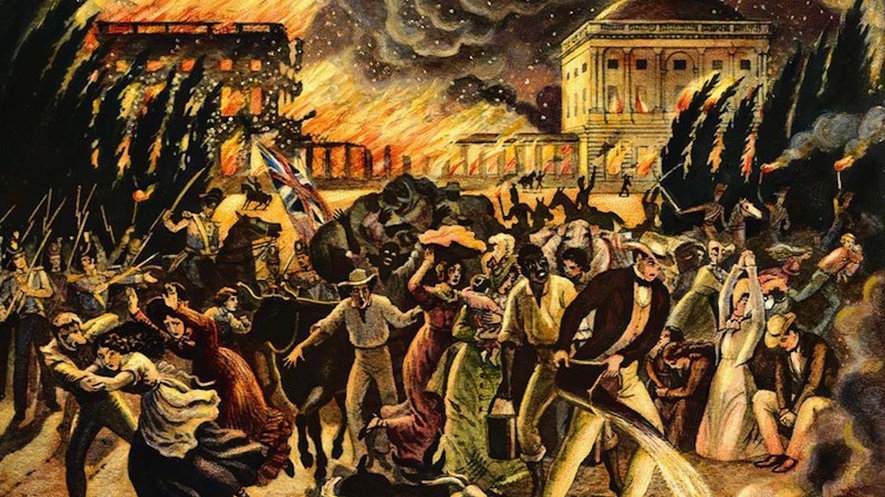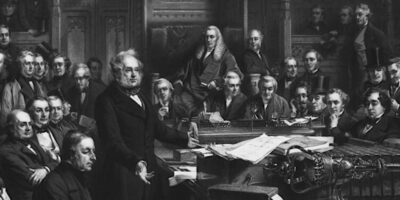Tariff Wars and the Fallacy of the Balance of Trade
The world may be on the brink of a series of trade wars between the United States and both the European Union and China. All the parties say they don’t want this — though President has asserted that trade wars are not a problem and easy to win. That remains to be seen!
It may have become a cliché, but we do live in a global economy. The days of actual or attempted national self-sufficiency are long gone. Even in some of the remaining most underdeveloped countries, multitudes of people walk around with cell phones seemingly glued to their ears, communicating with family, friends and business associates a mile away or on the other side of the world.
The clothes that people wear, the music they listen to, the foods they often eat, many of the everyday goods they buy are frequently imported from other continents or from facilities in their own country or region of the world that are owned and operated by international corporations and companies or their local affiliates that serve everyone, everywhere.
An Interconnected and Interdependent World
Manufacturing supply-chains often zig and zag back and forth from one country or continent to another before the final products are ready to be shipped to and sold at the retail stores where the finished goods are offered to ultimate consumers all over our planet. Raw materials are mined or extracted in country “X,” then shipped for refining in country “B,” after which they are sent off to country “C” as an input or component part for the manufacture of a product in country “D,” and then sent on to country “E” for final assembly and finishing up, followed by being shipped off for sale in multitudes of other countries, including those in which these steps in the worldwide stages of the production process have all been undertaken. Labels on things may still say, made in the USA, or made in China, or made in India, or made in Costa Rica, or . . . But in fact they are products made across the globe to serve and satisfy all of us as consumers, after many of us have participated in the respective production processes in the international system of division of labor that improves the standards and qualities of living of almost all of the over seven billion people inhabiting Planet Earth. While the degrees, forms and interconnections of this global division of labor have intensified and become more complex in our modern times, there is nothing new in all this. Indeed, it is a process that has been going on, now, for centuries. For instance, almost 250 years ago, the famous Scottish philosopher and economist, Adam Smith, explained in his book, The Wealth of Nations (1776) the then already existing network of global trade just for the manufacture of a simple and modest day laborer’s coat: “Observe the accommodation of the most common artificer or day-laborer in a civilized and thriving country, and you will perceive that the number of people of whose industry a part, though but a small part, has been employed in procuring him this accommodation, exceeds all computation. “The woolen coat, for example, which covers the day-laborer, as coarse and rough as it may appear, is the produce of the joint labor of a great multitude of workmen. The shepherd, the sorter of the wool, the wool-comber or carder, the dyer, the scribbler, the spinner, the weaver, the fuller, the dresser, with many others, must all join their different arts in order to complete even this homely production. “How many merchants and carriers, besides, must have been employed in transporting the materials from some of these workmen to others who often live in a very distant part of the country! How much commerce and navigation in particular, how many ship-builders, sailors, sail-makers, rope-makers, must have been employed in order to bring together the different drugs made use of by the dyer, which come from the remotest corners of the world! “What variety of labor too is necessary in order to produce the tools of the meanest of those workmen! To say nothing of such complicated machines as the ship of the sailor, the mill of the fuller, or even the loom of the weaver . . .” What seemed like such an unnoticed marvel in the time of Adam Smith in terms of the production of a simple item of clothing has been multiplied hundreds of thousands of times to our own day and age in terms of our mutual and tightly knit interdependency with people in every other part of the world. The World Trade Organization (WTO) estimates that in 2017 global output came to $74 trillion. The largest contributors to the world’s economy in 2017 were the United States with a 24.3 percent share of global output, followed by the European Union (EU) having a share of 23.1 percent of the world’s production, with China next in line with 14.8 percent of global output. Combined, they made up over 62 percent of the entire world’s production. At the same time, the value of all import-export trade in manufactured goods and services around the world came to over $35 trillion in 2017. That is, internationally traded goods and services made up over 47 percent of global output. Of this total, the U.S. combined imports and exports represented 11.5 percent of that $35 trillion in global trade, the European Union, almost 16 percent, and China, 16.5 percent. Together, America, the EU and China contributed 44 percent of the international trade in goods and services. This means that any trade wars between the United States and the EU and China could dramatically impact not only the economic “belligerents” in such a conflict, but inescapably many other parts of the world, as well. After all, those production links in the worldwide supply-chains connect the U.S., the EU and China with many other countries that would, in various ways, experience the “fallout” from tariff and other trade restricting attacks and retaliatory counter-attacks between the actual “combatants.” If foreign trade among the nations of the world plays such a large and significant part of almost everyone’s interdependent economic well-being, then why are trade wars threatened among the three largest participants in global production and exchange? The answer is: Donald Trump’s view of the world. During his presidential campaign in 2016 and now into the second year of his presidency, Mr. Trump insists that America is being taken advantage of by its trading partners, especially though not exclusively, the European Union and China. He has also railed against Canada, Mexico and a host of other countries. What is the basis of his accusations, and do they have any real importance or significance in terms of American standards of living and job opportunities within the country? The first one worth discussing is Trump’s charge that America’s trade deficits with the world in general and with China in particular are harmful to the present and future economic betterment of the people of the United States. According to the United States Census Bureau, in 2017 total U.S. exports of goods came to a dollar value of a bit more than $1.54 trillion; foreign goods imported into the United States totaled $2.34 trillion, resulting in a trade deficit of about $796 billion. With China, in particular, U.S. exported goods totaled slightly less than $130 billion, while imports of goods from China came to around $505 billion, for a trade deficit of over $375 billion with China. Mr. Trump insists that these trade deficits are, in themselves, proof that America is a “loser” in the arena of global trade. In this, the president shows that he has fallen into many of the same Mercantilist fallacies of the eighteenth century that Adam Smith and others after him refuted long ago. The gains from trade do not come from what is exported, but from what is imported, and this applies to both an individual or to a group of individuals defined as the combined citizens of any particular country. A balance of trade deficit or surplus in finished goods, therefore, tells little about the overall economic situation for a person or a country. Looking at trade deficit data since 1992, there seems to be a clear method for reducing it in the way that Trump desires: have a financial crisis and enter into recession. I earn my living as a professor of economics. I use this niche in the division of labor as the means to supply others with economics lectures and writings of various sorts so to earn my regular money income. But my selling of these economics lecture services is not an end in itself. It is the means by which I acquire the money revenues to have the financial wherewithal to reenter the market as a consumer to demand all the large variety of goods that others have for sale that I am unable or unwilling to make for myself. I have trade deficits and trade surpluses with a large number of my trading partners in society. Many of the students (or their parents) who pay the tuition to the institution for higher learning through which I’m paid my teaching salary likely produce few if any of the particular goods and services I’m interested in buying. As a result, I have a trade surplus with most of those to whom I sell my teaching abilities. That is, they buy more from me than I buy from them, which, of course, means that those paying the tuition have a trade deficit with me, in that the dollars they spend to pay my salary is more than I likely spend on buying the goods and services those specific students or parents bring to market as their own way of earning a living. On the other hand, most of those from whom I buy the wide variety of goods upon which I spend my money income are – shockingly! – probably not interested in hearing economic lectures I could deliver or reading economics articles that I write. Hence, I buy far more from those particular individual sellers of goods than they spend on my economics teaching and writing services, with the money they’ve earned from supplying me with the goods and services I desire as a consumer. Thus, I run balance of trade deficits with these sellers and they have balance of trade surpluses with me, the buyer, as the flip side of those transactions. This is a primary advantage of a money-using economy rather than one based on direct barter exchange. I do not have to find just the right people who have what I want to buy and reciprocally desire the specific good I could offer in trade for their wares. Instead, I can earn money income from some who may have nothing I’m interested in buying and use that money income to purchase what others have for sale who may have no interest in the particular good or service I bring to the market as a seller. What does have to balance is my overall balance of payments. That is, my income-earning inflows have to equal my income-spending outflows, regardless of my individual balances of trade with all the individuals with whom I interact in the marketplace. But I need not have a “balance” just in terms of actual goods and services I sell to and buy from others. I can also save or borrow. If I spend less than my income, I save, and in our modern world savings do not sit idle under a mattress. I lend that savings out (through financial intermediaries) to others who desire to spend in the present more than their own financial means would allow them to, and from which I expect to earn, as the lender, future interest income. The borrower agrees to this because he considers the profitable opportunities to use someone’s else’s savings closer to the present more than justifies the paying of that interest, plus the paid back principle, at that point in the future. Again, on the overall balance sheets there would be included a record of savings lent and expected future interest income earned for the lender. And for the borrower, an entry of money borrowed in the present and anticipated profits to be earned and interest payments to be made in the future. The two individual’s balance of payments will, respectively, balance. What has this have to do with the U.S. balance of trade deficit? It is merely the same logic just discussed, only on a wider national canvas. The error in the balance of trade hysteria is a failure to look at and incorporate all the columns that should be included on the ledger book of America’s trade with the rest of the world. Let’s use an example. In 2017, the U.S. had a balance of trade deficit with Japan. American export of goods to Japan came to almost $68 billion; but Americans imported and purchased over $136 billion of Japanese goods, resulting in a trade deficit of nearly $69 billion. But what did the Japanese manufacturers who earned that $69 billion do with that sum? Part of that money took the form of direct foreign investment in the United States. That is, some of those Japanese earners of dollars used them to invest in, start up or expand a business in the U.S. Those dollars would have been partly spent on buying or leasing land; in purchasing an existing factory facility or building a new one; in purchasing goods, services, and component parts from American suppliers; and hiring American workers to work in the business. Or those Japanese earners of dollars may have indirectly invested in the United States, by leaving on deposit some of those dollars in American financial institutions to earn future interest income, no different than when you or I set aside some of the income we’ve earned to increase our savings nest egg looking to tomorrow by lending to others and earning interest income. At the same time, to the extent that Japanese and other foreign exporters leave a part of their unspent dollar earnings on deposit in U.S. financial markets, they add to the pool of savings available to American borrowers to draw upon, which lowers what might otherwise have been the cost of borrowing in the United States and increases the savings wherewithal to undertake potentially profitable investments within America. But what if some of these Japanese export earners of dollars did not want to buy more American finished goods or services, or did not want to spend more on direct investment within the United States, or did not find U.S. financial security and interest rates sufficiently attractive to leave more in American banks? Suppose that, instead, some of those Japanese exporters were more interested in buying, say, goods available in Europe. In this instance, these Japanese would enter the foreign exchange market and offer to sell dollars for desired Euros, or British pounds, or Swiss francs. Someone would be found to sell certain amounts of those European currencies in exchange for those dollars at the prevailing foreign exchange rates. And why would someone sell these currencies for those dollars unless they wanted to do, what? Buy American goods, directly investment in American enterprises, or indirectly invest in the U.S. by having dollars to deposit at American financial institutions in return for promised interest income. Adding up all the relevant columns in the overall balance of payments of the United States – all finished goods and services imported and exported between America and the rest of the world; all direct foreign investment in the U.S. and all American direct foreign investment in other places around the globe; all indirect investment by Americans elsewhere and all foreign indirect investment within the United States; plus a variety of other remittances, payments and receipts, and it is found that the American balance of payments balances. The hoopla and hysteria about balance of trade deficits, and that somehow “others” are taking advantage of us because we buy more from them than they buy from us, in fact, is the result of an analytical myopia of failing to “follow the money” through all the different forms and channels that import and export spending can take, both for an individual or the country as a whole. Once you do, you realize that the balance of trade “problem” is all an illusion. Donald Trump is threatening to possibly unleash a series of trade wars with the European Union, China and a number of other countries based a misguided, indeed, a false conception of the meaning of America’s trading patterns with the rest of the world. The optimistic scenario, according to Mr. Trump and his supporters, is that other countries need the American market so much more to sell and buy than Americans need them that they will “cave.” That is, they will give in to Mr. Trump’s desired renegotiated terms of trade rather than face the consequences from trade wars that America can weather better than them. That’s the assumption behind the president saying that trade wars are “easy to win.” But what if Mr. Trump is wrong? What if, instead, America’s trading partners follow through with their stated declarations of planned retaliatory counter-tariffs, if the president implements all the higher import duties against an expanded number of foreign goods that he has promised to do in the near future? Mr. Trump’s temperament, as we’ve seen over the last couple of years, is to double down against those who question, challenge, or oppose him on almost any issue on which he takes a public stand. To do otherwise, in his mind, is a sign of weakness , which means you lose and the other guy wins. Mr. Trump’s erroneous understanding of trade accounts and his often arrogant assumption of knowing far more than any others around him – combined with his personality of taking all challenges to whatever he says or does as personal affronts to which he must forcefully respond – may very well end up being the human frailties that set in motion destructive trade wars among the leading economies of the world. Adam Smith and the Global Reach of Production
Global Production and Trade
Donald Trump’s View of World Trade
Specialized Trade Equals Multitudes of Trade Deficits and Surpluses
The Overall Trade Ledger Book Does Balance
Trade Includes Goods, Services, and Direct and Indirect Investment
Misconceptions About Trade Deficits Can Trade Wars Make












